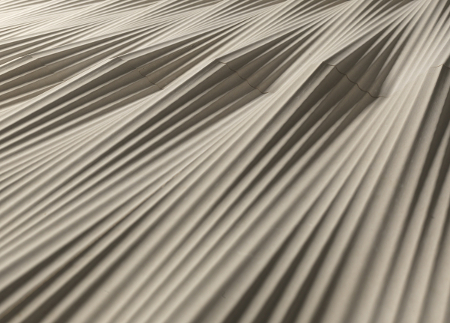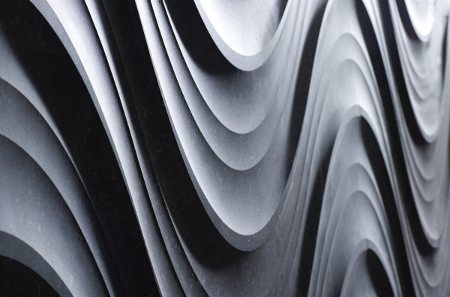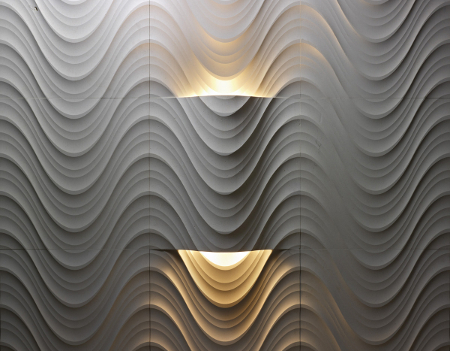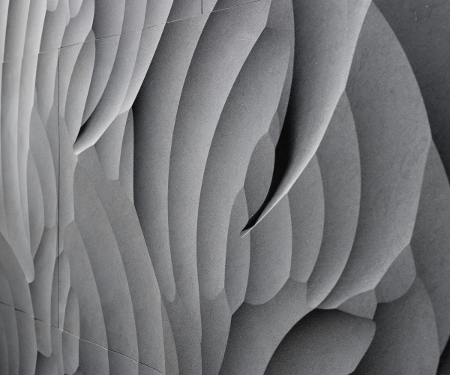12 Febbraio 2013
English
Contemporary stone ornamentation (part 2)

Last generation tools, like artificial, somatic elements that complement the prefigurations of the creative mind, are used with singular refinement and create a clear distinction in the quality of products, compared to many of those created in the more regimented, traditional context of industrial marble work, a sector that is often characterised by mass produced objects that are repeated and do not vary over the years.
When their special features and versatility are explored, tools are pushed to the limits of their possibilities. Machines with an intelligent touch, like the hands of a sculptor that never tires, first leave a two-dimensional outline on stone and then, increasingly decisively, create a glyphic outline on its surface. This superficial erosion fixes first the rough outline and then the final appearance of objects, blending completely new material, geometric and even communicative arrangements.
Stone decorated in this way with perceptive, tactile and visual geometries offers the possibility of a physical experience and, through aesthetic expression, is cloaked in meanings that go beyond the functional nature of simple surfaces. The effect they have on the senses imbues them with expressivity and the power of attraction.
Stopping to observe them is a sensory experience and an invitation to reflect on a theme that is always latent, linked to the sense of the form and nature of design: the concept of ‘ornamentation’.
Our aim here is not to produce a short history of ornamentation, or a critical review of the opinions that many authors1 have held on the subject. What is interesting is the use of several terms linked in sense and evocation, to interpret Raffaello Galiotto’s research with adequate tools and to position it in modern trends in design.
If we reflect upon ‘ornamentation’ and ‘decoration’, rather than thinking that the affirmation and denial of these concepts move according to the scheme of the recurrent cycles of human history, we consider it more appropriate to interpret the presence or absence of ornamentation as features that exist dialectically and contextually even in eras dominated by homogeneous, conformative linguistic and formal trends, and appear with congenital duality, if not plurality.
Therefore, together with reductionism – the elimination of the ‘superfluous’, the artificial and of colour – there are moments in which representation, valorisation of detail and virtuoso feats of shapes and colours recur.
‘Minimalism’ co-exists with research in which language moves closer to different representative strategies, where the studied complexity of lines, curves and bends in the material is an added value and mark of design.

Here we would like to investigate the concepts of ‘representation’, ‘covering’ and ‘ornamentation’, considering them as possible themes rooted in the conceptual and cultural nature of design, which orientate the designer along the path of his or her personal research.
Negation, elision or absence of ‘ornate’ workmanship on stone surfaces, may lead one to think that ‘function’ alone is able to confer a profound significance on form, prevailing over it in an unequal dualism. However, if function alone were able to produce formal structure through a process of logical necessity, design would result in a paradox, in a loss of the nature of the external epidermis and the cancellation of the aforementioned ‘ornamental’ qualification.
However, we prefer the idea that ornamentation is not a secondary element to creation, but a necessary one. It is in itself ‘design’ and leads to the discovery and revelation of form.
The meaning of the term ‘ornamentation’, which is so closely related to the concepts of ‘decoration’ (and often ‘covering’) has changed over time.
At the beginning of the 20th century, the complex management of industrial cycles undoubtedly led design along the path of simple, linear forms, which were easier to produce, leading to contemporary ‘purism’. However, the issue of ornamentation, moved by forces and drives within the material itself, has re-emerged with unexpected vitality.
The interpretative reference we will use to give substance to this reflection, is that of a philosopher from a far-off country – Ananda K. Coomaraswamy – one of the greatest scholars of the relationship between the symbolic wisdom of the East and Western culture, whose critical distance can help us understand the original aims of ornamentation and interpret the concept.
In his essay “Ornament”2, Coomaraswamy investigates the complexity of the term and traces it back to its archetypal nature.
If we return to its roots, the word “ornament” is etymologically linked to the Latin words ordo and ordinatio (in all likeness it is the word ‘ordinare’ shortened to ord’nare) and to the corresponding Greek kósmos.
The first meaning is that of ‘order’, referring both to everything being in the right place and the much broader ‘world order’. Secondly, order is a synonym of ‘ornament’, beautifying people, animals, spaces or an attribute of language (in rhetoric, ornatus).
Just as kosmetikós means ‘skilled in the art of adornment’, Kosmopoiesis is architectural ornamentation, from which comes architectural ‘orders’. Classical architecture reached its highest level of harmony and stylistic perfection through ornament and its material potential; not as a superfluous element, but as an integral factor in harmonising art and technology, an element of connection between form and meaning, between the function and sense of things.
In the words of Coomaraswamy:
“(…) we are not concerned with beauty, which is traditionally proportionate to the perfection of the artifact itself (…); our concern is rather with the aesthetic view of art, and the decorative values of art, which depend on taste and liking rather than on judgment. (…) various words that have been used to express the notion of an ornamentation or decoration and which in modern usage for the most part import an aesthetic value added to things of which the said “decoration” is not an essential or necessary part.”3
Here the expression “art” can easily be transformed into “industrial design”, if we think of a context where representational activity and formal-implementational definition have a clear link with the production of artefacts, whether they are exclusive or mass-produced items.
To return to the origins, ornamentation was needed for the completeness of forms. It meant ensuring that an object – or even a person – filled with semantic values, could fulfil their function properly, effectively and with influence.
In modern usage the term has moved towards indicating, for the most part, a superfluous and non-essential aesthetic value, something unnecessary and even ‘luxurious’ added to the object of use and, as such, to be erased in order to restore its original purity.
However, if we observe Galiotto‘s creative workshop, treating the product of stone design as the result of a process, the practical connotation of ornament dominates the aesthetic element.

[photogallery]ornamento2_album[/photogallery]
If we recognise how the fluid combinability of ‘Le Pietre Incise’ has evolved in the ‘Materia Litica’ project, transforming into extremely thick blocks to then return to the plastic lightness of the ‘Drappi di Pietra’ collection, we can see how the ornamentation created by the lines – whether they are extensions of a profile or extreme intersections of an interlacement – is nothing other than the expression of a serial logic of industrial production, needed to achieve formal structure.
Lines, curves and bends in the material allow us to explore the expressive language of stone. Creative intelligence, knowledge of production techniques and the eloquence of ornate surfaces seem inextricably linked in the work of Raffaello Galiotto and Lithos Design, almost a perfect response to the appeal launched at the end of Coomaraswamy’s “Ornament”:
“(…) and suggest to the “designer” that if all good ornament had in its beginning a necessary sense, it may be rather from a sense to be communicated than from an intention to please that he should proceed.”4

Note
1Related to this theme is the discussion that gave life to ‘Applied Industrial Arts’, to then found ‘Industrial Design’, in its modern sense. A succession of great philosophers have applied themselves to this reflection. Without citing the Ancients and the work of several pioneers, (such as Quatrèmere de Quincy and Karl Bötticher), the theme of ornamentation can be said to have been fed at the outset of modernity by Gottfried Semper, in his theories on the textile origin of architecture, (Gottfried Semper, Die vier Elemente der Baukunst, 1851) and therefore to have animated the impassioned theories of Alois Riegl, Adolf Loos, Otto Wagner, H. Petrus Berlage and Georg Simmel. Over the years the list of philosophers has reached the present day, offering ‘ornament’ and ‘decoration’ for modern critical analysis in a way that is not radically different (except in its high tech tools) from the origins of design disciplines.
2 Ananda Kentish Coomaraswamy, L’ornamento, pp. 187-200, in Il grande brivido. Saggi di simbolica e arte, Milan, Adelphi Edizioni, 1987, pp. 532 (ed. or. Selected Papers. Traditional Art and Symbolism, Princeton University Press, 1977).
With immense erudition, the Sri Lankan philosopher and historian (Ceylon 1877 – Massachusetts 1947) investigated the roots of thought, rite and symbolism in the arts, producing an incomparable and illuminating blend between East and West.
He published the essay Ornament in Art Bulletin, n. 21, New York, College Art Association of America, 1939.
3 Ananda Kentish Coomaraswamy, Ornament, in Art Bulletin, n. 21, New York, College Art Association of America, 1939, pp. 375-376.
4 Ananda Kentish Coomaraswamy, Ornament, in Art Bulletin, n. 21, New York, College Art Association of America, 1939, p. 382.
